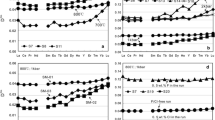Abstract
To estimate the behavior of Au, Pd, REE, and Y in magmatic and postmagmatic processes, a series of experimental studies on the solubility of noble metals and REE in magma, magmatic fluid, and hydrothermal solutions has been performed in wide temperature and pressure ranges (300–400°C, 860–1350°C; 1–14 kbar). The coefficients of Au and Pd partitioning (D F/L) between fluid and tholeiitic melt have been determined. Depending on P, T, and the composition of the system, they vary from 1 to 11 for Au and 0.02 to 1 for Pd. The phase solubility technique was used to determine Au and Pd solubility in hydrothermal fluid. The effects of temperature, composition, and fluid acidity on Au and Pd solubility have been estimated. The high solubility of these metals in aqueous chloride solutions has been established for both Au (28–803 mg/kg at T = 300°C, 305–1123 mg/kg at T = 350°C, and 330–1400 mg/kg at T = 400°C) and Pd (40–126 mg/kg at T = 300°C, 62–152 mg/kg at T = 350°C, and 20–210 mg/kg at T = 400°C). The coefficients of REE and Y partitioning (D F/L) between fluid and tholeiitic or alkaline melts have been determined. They vary from 0.00n to 2 depending on P, T, and fluid composition. The experimental data on Au and Pd solubility in solutions and magmatic fluids and the wide variation of REE D F/L between fluid and melt show that magmatic and hydrothermal fluids are efficient agents of Au, Pd, and REE transfer and fractionation. The obtained experimental data were used for elucidating sources of fluids and their role in the genesis of Au-Pd-REE occurrences in the Subpolar Urals.
Similar content being viewed by others
References
T. P. Dadze and V. I. Sorokin, “Experimental Determination of H2S, HSO −4 SO2(aq), H2S2O3, S 0(sol) , and Stot in Aqueous Phase of the S-H2O System At Elevated Temperatures,” Geokhimiya 31(1), 38–53 (1993).
L. I. Efanova, Candidate’s Dissertation in Geology and Mineralogy (Syktyvkar, 2001).
R. T. Flynn and C. W. Burnham, “An Experimental Determination of Rare Earth Partition Coefficients between a Chloride-Containing Vapor Phase and Silicate Melts,” Geochim. Cosmochim. Acta 42, 685–701 (1978).
O. L. Galankina, V. V. Gavrilenko, and I. M. Gaidamako, “New Data on Mineralogy of Hydrothermal Gold-Platinum Mineralization of the Subpolar Urals,” Zap. Vseross. Mineral. O-va 127(3), 72–78 (1998).
N. S. Gorbachev, Fluid-Magmatic Interaction in Sulfide-Silicate Systems (Nauka, Moscow, 1989) [in Russian].
N. S. Gorbachev, G. Brügmann, A. Naldrett, et al., “Redox Conditions and PGM Distribution in Sulfide-Silicate Magmatic Systems,” Dokl. Akad. Nauk 331(2), 220–223 (1993).
N. S. Gorbachev, G. Brügmann, A. I. Naldrett et al., “Experimental Study of PGM and Au Partitioning between Aqueous Chloride Fluid and Basaltic Melt at T = 1100–1350°C, P = 5 Kbar,” Dokl. Akad. Nauk 335 (3), 356–358 (1994).
N. S. Gorbachev, T. P. Dadze, A. F. Kunts, and A. V. Kostyuk, “Experimental Modeling and Mineralogical-Geochemical Study of Au-Pd-REE Ore Formation,” Syktyvkar. Mineral. Sb. 34(118), 47–65 (2005).
A. V. Kozlov, “Main Factors Controlling Epigenetic Mineralization in the Subpolar Urals,” in Geology and Mineral Resources of the European Northeast of Russia: New Results and New Perspectives (Syktyvkar, 1999), Vol. IV, p. 42–44 [in Russian].
S. K. Kuznetsov, L. I. Efanova, and G. V. Chuprov, “Gold of the Al’kesvozh Site in the Subpolar Urals,” Syktyvkar. Mineral. Sb. 33(115), 82–93 (2003).
S. K. Kuznetsov, M. B. Tarbaev, T. P. Maiorova, et al., Noble Metals on the Western Slope of the Urals and Timan (Geoprint, Syktyvkar, 2004) [in Russian].
D. London, R. L. Herving, and G. B. Morgan, “Melt-Vapor Solubilites and Elemental Partitioning in Peraluminous Granite-Pegmatite Systems: Experimental Results with Macusani Glass at 200 MPa,” Contrib. Mineral. Petrol. 99(4), 360–373 (1988).
V. I. Mizin and A. A. Soboleva, “Accessory Minerals of the Malda Rhyolitic Subintrusion,” in Igneous and Metamorphic Rocks of the Northern Urals and Timan (Syktyvkar, 1991), No. 74, p. 39–43 [in Russian].
V. S. Ozerov, “Genesis of the Chudnoe Ore Occurrence, the Subpolar Urals,” in Gold, Platinum, and Diamonds of the Komi Republik and the Adjacent Regions (Syktyvkar, 1998), p. 16–18 [in Russian].
V. S. Ozerov, “Metallogeny of the Malda Liparite Intrusion, the Subpolar Urals,” in Granitoid Volcanic-Plutonic Associations: Petrology, Geodynamics, and Metallogeny (Geoprint, Syktyvkar, 1997), p. 70–72 [in Russian].
I. Kh. Shumilov and B. A. Ostashchenko, Mineralogical and Technological Features of Au-Pd-REE Mineralization in the Subpolar Urals (Geoprint, Syktyvkar, 2000) [in Russian].
I. Kh. Shumilov and V. N. Filippov, “Mineralogy of Gold-Palladium Mineralization of the Chudnoe Ore Occurrence,” Syktyvkar. Mineral. Sb. 27(74), 47–65 (1998).
A. A. Soboleva, Rhyolites in the Subpolar Urals and the Southern Polar Urals (Geoprint, Syktyvkar, 1995) [in Russian].
M. B. Tarbaev, S. K. Kuznetsov, G. V. Moralev, et al., “A New Gold-Palladium Type of Mineralization in the Kozhim District of the Subpolar Urals,” Geol. Rudn. Mestorozhd. 38(1), 135–146 (1996) [Geol. Ore Deposits 38 (1), 11–25 (1996)].
V. A. Zharikov and N. S. Gorbachev, “Experimental Study of REE Partitioning between Fluid and Basaltic Melt at P = 5 kbar and T = 1100–1350°C,” Dokl. Akad. Nauk 330(3), 363–365 (1993).
V. A. Zharikov and N. S. Gorbachev, “Behavior of REE in Fluid-Magmatic Systems: Experimental Data,” in Experimental Mineralogy. Summary at the Turn of Centuries (Nauka, Moscow, 2004), Vol. 1, p. 21–37 [in Russian].
V. A. Zharikov, N. S. Gorbachev, P. Lightfoot, and V. Doherty, “Partitioning of REE and Y between Fluid and Basaltic Melt under a Pressure of 1–12 kbar from Experimental Data,” Dokl. Akad. Nauk 367(4), 243–246 (1999).
Author information
Authors and Affiliations
Corresponding author
Additional information
Original Russian Text © N.S. Gorbachev, T.P. Dadze, G.A. Kashirtseva, A. F. Kunts, 2010, published in Geologiya Rudnykh Mestorozhdenii, 2010, Vol. 52, No. 3, pp. 241–259.
Rights and permissions
About this article
Cite this article
Gorbachev, N.S., Dadze, T.P., Kashirtseva, G.A. et al. Fluid transfer of gold, palladium, and rare earth elements and genesis of ore occurrences in the Subpolar Urals. Geol. Ore Deposits 52, 215–233 (2010). https://doi.org/10.1134/S1075701510030037
Received:
Published:
Issue Date:
DOI: https://doi.org/10.1134/S1075701510030037




